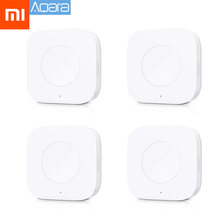First, are you sure there are no requirements? Check the building codes/laws in your region.
Back to your question: the devices you linked to are Xiaomi devices. They can be paired to Hubitat, and if you install a custom driver, they are usable, but they are not standard Zigbee HA 1.2 devices (Hubitat is a ZHA 1.2 controller), and as such have some oddities. Most notably, many (most?) Zigbee repeaters/routers do not work well with them, and they will eventually fall off your network. A few have been found to work well (Ikea Tradfri outlet, a carefully configured Xbee, possibly the ST 2018 outlet, and a couple other products that are no longer readily available on the market--compared to many more that are known to cause problems). You can make them work (or at least many people can), but you have to be careful with how you build your Zigbee mesh. If you want something similar that is standard ZHA (technically Zigbee 3.0), the SmartThings 2018 Button is a good option and usually doesn't cost much more.
But you don't have to limit yourself to single buttons. There are many button devices that work with Hubitat, some of which have multiple buttons like you'd expect from a switch. This post explains all that are natively supported, along with their capabilities: Hubitat Elevation supported button controller capabilities matrix. In my opinion, options that look vaguely like a switch and are likely to be intuitive for other users include the Hue Dimmer, the Eria Dimmer, the Osram 2-button dimmer (a bit bulky, though), and the Pico remotes (but these require the Lutron Smart Bridge Pro at considerable more expense--but the remotes are cheap and may be worth it if you get a lot).
Even if code doesn't require switches, I'd strongly encourage you to include them, anyway. If you sell the house, the new buyer will probably want them, and it would be less work to do that now. You can also reduce your dependence on battery-powered remote/button devices by using smart switches, even if you want smart bulbs. Some smart switches support disabling the internal relay, which means that when you press the switch to turn something "on" or "off," it doesn't actually cut (or return) power to the load--it just sends a command to the hub, which you can then interpret however you want. All generations of Inovelli switches and dimmers support this, and Zooz either does or will soon with many of theirs (ask their support before buying if not sure). You can also really do this with any switch by wiring line and load together, but the ones that allow this as a configurable parameter are nice so you don't have to re-wire if you change your mind.
If you go with a smart switch, both of the manufacturers I mentioned also have "scene switches" where your options aren't limited to just single tap up or down: you can also multi-tap, which you can assign to whatever functions you want (different colors, dimming, other rooms, other devices besides lights, etc.). While a bit more expensive than some button devices, I'd consider this a pretty good option: you'll get the house wired for switches, have "button"-type devices that look and work like switches to people who aren't familiar with your house, and you can swap them and out and replace with "regular" switches if/when you move without having to hire an electrician to run new cabling.
The only one Philips makes without a battery is the Hue Tap, which does not currently work with Hubitat. (If you have a Hue Bridge and integrate the network that way, the Tap can be used to control Hue devices, and eventually Hubitat will get the devices' updated status, but there's no way to get the button press directly into Hubitat. Not really a problem for the way I use them, but just worth noting.)


